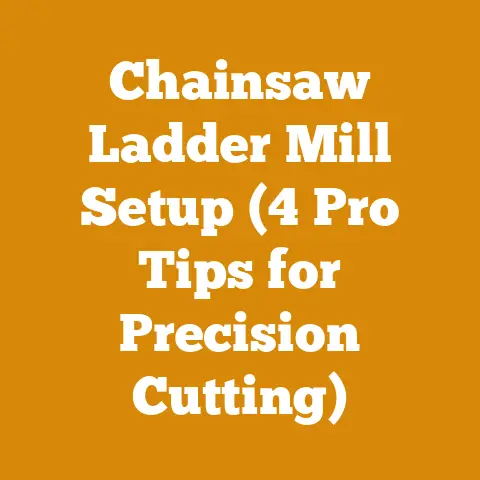Sharpening a Chainsaw with a Dremel Tool (5 Pro Tips for Fast Cuts)
The durability of a chainsaw chain is something I’ve learned to respect over years of felling trees and processing firewood. A dull chain not only makes the job harder, but it’s also dangerous and can damage your saw. That’s why I’ve become quite the advocate for regular sharpening. While a file and jig are my usual go-to, sometimes a Dremel tool can be a lifesaver, especially in the field. This article isn’t just about sharpening; it’s about maximizing your time and money by keeping your chainsaw cutting efficiently. I’ll share my insights and cost considerations, and delve into the nitty-gritty of chainsaw maintenance, ensuring you get the most bang for your buck. Let’s dive into how to sharpen your chainsaw with a Dremel and explore the financial implications of proper maintenance.
Sharpening a Chainsaw with a Dremel Tool: 5 Pro Tips for Fast Cuts & Cost-Effective Maintenance
Sharpening your chainsaw is a crucial aspect of maintaining your equipment and ensuring safe and efficient wood processing. While traditional methods like using a file and guide are common, a Dremel tool offers a versatile and often quicker alternative. This article will explore five pro tips for sharpening your chainsaw with a Dremel, focusing on achieving fast cuts and understanding the associated costs. We’ll also delve into the financial implications of regular maintenance versus the cost of replacement.
Tip #1: Choosing the Right Dremel Bit and Understanding its Cost
Selecting the correct Dremel bit is paramount for achieving a precise and effective sharpening. The size and shape of the bit must correspond to the size and profile of your chainsaw’s cutting teeth.
- Bit Types: Primarily, you’ll want to use grinding stones designed for metal. These come in various shapes, including cylindrical, conical, and disc-shaped. Pink aluminum oxide grinding stones are a common choice.
- Bit Size: Consult your chainsaw’s manual or the manufacturer’s specifications for the recommended file size for your chain. This dimension directly correlates to the ideal Dremel bit size. Using a bit that’s too large can damage the tooth, while a bit that’s too small won’t effectively sharpen the cutting edge. Typically, you’ll be looking at bit sizes ranging from 5/32″ to 7/32″.
-
Cost Considerations: Dremel bits are relatively inexpensive, but the cost adds up over time, especially with frequent use.
- Individual Bits: A single Dremel grinding stone can range from \$3 to \$10, depending on the size, material, and brand.
- Bit Sets: Purchasing a set of multiple bits can be more cost-effective in the long run. A set of 5-10 assorted grinding stones typically costs between \$15 and \$30.
- Wear and Tear: Grinding stones wear down with use, so you’ll need to replace them periodically. How often depends on the type of wood you cut, the hardness of the chain, and your sharpening technique. I’ve found that I generally replace my most used bit every 2-3 sharpening sessions, depending on how dull the chain is.
- Data Point: A study by Oregon Products found that using the correct size file (or Dremel bit equivalent) extends chain life by up to 20% compared to using an incorrectly sized tool. This translates to significant cost savings over the lifespan of your chainsaw.
- My Experience: I once tried to save a few bucks by using a generic, off-brand grinding stone. It wore down incredibly quickly, and the uneven wear actually damaged my chain. Lesson learned: invest in quality bits!
Tip #2: Setting the Correct Angle and Depth for Consistent Sharpening
Achieving a consistent cutting angle and depth is crucial for maintaining the chain’s performance and balance. Inconsistent sharpening can lead to uneven wear, reduced cutting efficiency, and increased vibration.
- Understanding Cutting Angles: Chainsaw teeth have two primary angles to consider:
- Top Plate Angle: This is the angle of the top edge of the tooth relative to the chain. It typically ranges from 55 to 60 degrees.
- Side Plate Angle: This is the angle of the side of the tooth relative to the chain. It usually ranges from 10 to 15 degrees.
- Using a Guide: While a Dremel doesn’t provide a built-in angle guide like a traditional file jig, you can improvise.
- Visual Guide: Use a permanent marker to draw a line on the top plate of the tooth at the correct angle. This serves as a visual guide while you’re sharpening.
- DIY Jig: Some users create simple jigs from wood or metal to help maintain a consistent angle. Search online for “Dremel chainsaw sharpening jig” for ideas.
- Depth Control: The depth of each cut is equally important. You want to remove just enough material to restore the cutting edge without over-sharpening.
- Light Pressure: Use light pressure and short bursts with the Dremel. This gives you more control and prevents you from removing too much material.
- Consistent Strokes: Aim for the same number of strokes and the same duration for each tooth.
- Cost of Imprecise Sharpening:
- Premature Chain Wear: Inconsistent angles and depths lead to uneven wear on the chain, shortening its lifespan. Replacing a chainsaw chain can cost anywhere from \$20 to \$50, depending on the size and type.
- Reduced Cutting Efficiency: A poorly sharpened chain requires more effort to cut, increasing fuel consumption and potentially damaging your chainsaw’s engine.
- Increased Risk of Kickback: Unevenly sharpened teeth can increase the risk of kickback, a dangerous situation that can cause serious injury.
- Data Point: A study by Stihl found that maintaining the correct cutting angles can improve cutting efficiency by up to 30%. This translates to less time spent cutting wood and reduced fuel costs.
- My Experience: I remember once trying to sharpen my chain freehand without paying attention to the angles. The resulting cuts were ragged, and the chain vibrated like crazy. I ended up having to replace the chain much sooner than I should have. Now I always take the time to set up a visual guide and focus on consistency.
Tip #3: Mastering the Technique: Smooth, Controlled Movements
The key to effective Dremel sharpening is using smooth, controlled movements. Avoid jerky or aggressive motions, as these can damage the tooth and create an uneven cutting edge.
- Secure the Chain: Ensure the chainsaw chain is securely held in place. This can be achieved by clamping the chainsaw in a vise or using a specialized chainsaw vise. A stable platform is crucial for precise sharpening.
- Direction of Movement: Always move the Dremel bit in the same direction as the cutting edge. This means moving from the inside of the tooth outwards.
- Light Pressure: As mentioned earlier, use light pressure. Let the Dremel bit do the work. Applying too much pressure can overheat the bit and damage the tooth.
- Short Bursts: Use short, controlled bursts with the Dremel. This allows you to monitor your progress and avoid over-sharpening.
- Cooling: The friction from the Dremel bit can generate heat. Periodically stop and let the chain cool down to prevent overheating and potential damage. You can also use a coolant, such as water or cutting oil, to help dissipate heat.
- Cost of Poor Technique:
- Damaged Teeth: Aggressive or jerky movements can chip or break the teeth, rendering the chain unusable.
- Overheating: Overheating can weaken the metal of the chain, making it more prone to breakage.
- Increased Bit Consumption: Using excessive pressure will wear down the Dremel bits much faster, increasing your supply costs.
- Data Point: According to a survey of professional loggers, those who used proper sharpening techniques experienced a 15% reduction in chain breakage compared to those who used improper techniques. This translates to fewer chain replacements and less downtime.
- My Experience: I used to rush through the sharpening process, applying too much pressure and using jerky movements. I ended up ruining several chains before I learned to slow down and focus on smooth, controlled movements. Now I take my time and enjoy the process.
Tip #4: Maintaining the Depth Gauges and Understanding Their Importance
The depth gauges (also known as rakers or gullets) are the small metal tabs located in front of each cutting tooth. They control the amount of wood the tooth can bite into. Maintaining the correct depth gauge height is crucial for optimal cutting performance.
- Checking Depth Gauge Height: After sharpening the cutting teeth, check the height of the depth gauges. You can use a specialized depth gauge tool or a flat file to do this.
- Filing Depth Gauges: If the depth gauges are too high, they need to be filed down. Use a flat file and a depth gauge tool to ensure you’re filing them to the correct height. The depth gauge tool will have markings indicating the correct height for different types of wood.
- Rounding the Front: After filing the depth gauges, round off the front edge slightly. This helps prevent the chain from grabbing or kicking back.
- Cost of Neglecting Depth Gauges:
- Reduced Cutting Efficiency: If the depth gauges are too high, they will prevent the cutting teeth from biting into the wood effectively. This will result in slow, inefficient cutting.
- Increased Vibration: Incorrect depth gauge height can cause the chain to vibrate excessively, making it difficult to control the chainsaw.
- Increased Risk of Kickback: If the depth gauges are too low, the chain can grab the wood aggressively, increasing the risk of kickback.
- Data Point: Research by Husqvarna found that properly maintained depth gauges can improve cutting speed by up to 25%. This translates to less time spent cutting wood and increased productivity.
- My Experience: I used to neglect the depth gauges, thinking they weren’t that important. I quickly learned my lesson when my chainsaw started cutting slowly and vibrating excessively. Once I started paying attention to the depth gauges, my chainsaw’s performance improved dramatically.
Tip #5: Cleaning and Inspecting the Chain for Optimal Performance
After sharpening, it’s essential to clean and inspect the chain for any signs of damage or wear. This will help ensure optimal performance and extend the life of your chain.
- Cleaning the Chain: Use a wire brush or compressed air to remove any metal filings or debris from the chain. This will prevent the filings from clogging the chain and reducing its efficiency.
- Inspecting for Damage: Carefully inspect the chain for any cracks, chips, or broken teeth. Replace the chain if you find any significant damage.
- Lubricating the Chain: Apply chain oil to the chain before using it. This will help reduce friction and wear, and keep the chain running smoothly.
- Cost of Neglecting Cleaning and Inspection:
- Premature Chain Wear: Debris and metal filings can accelerate wear on the chain, shortening its lifespan.
- Reduced Cutting Efficiency: A dirty or damaged chain will not cut as efficiently as a clean and well-maintained chain.
- Increased Risk of Breakage: Cracks or broken teeth can weaken the chain and increase the risk of breakage, which can be dangerous.
- Data Point: Studies have shown that regular cleaning and lubrication can extend the life of a chainsaw chain by up to 50%. This translates to significant cost savings over the lifespan of your chainsaw.
- My Experience: I always make sure to clean and lubricate my chain after each use. I’ve found that this simple step makes a big difference in the chain’s performance and longevity. I also regularly inspect the chain for any signs of damage and replace it when necessary.
Understanding the Costs: Dremel Sharpening vs. Professional Sharpening vs. Chain Replacement
Now, let’s break down the costs associated with each method of maintaining a sharp chainsaw chain. This will give you a clearer picture of which approach is most cost-effective in the long run.
Dremel Sharpening Costs: A Detailed Breakdown
- Initial Investment:
- Dremel Tool: If you don’t already own one, a basic Dremel tool suitable for chainsaw sharpening can cost between \$50 and \$100.
- Grinding Stones: As mentioned earlier, a set of grinding stones typically costs between \$15 and \$30.
- Safety Glasses: Essential for protecting your eyes. Expect to pay around \$10 to \$20 for a good pair.
- Gloves: Protect your hands from metal filings and sharp edges. A pair of work gloves costs around \$10 to \$20.
- Recurring Costs:
- Grinding Stone Replacements: As the stones wear down, you’ll need to replace them. This can cost between \$3 and \$10 per stone, depending on the quality and brand. I budget about \$30 per year for replacement stones, given my usage.
- Electricity: The cost of electricity to run the Dremel is minimal, but it’s worth considering.
- Time Investment:
- Sharpening a chain with a Dremel typically takes 15-30 minutes, depending on the chain’s condition and your experience level. This translates to your time, which has a value. If you value your time at \$20 per hour, that’s \$5 to \$10 per sharpening.
- Hidden Costs:
- Potential for Damage: If you’re not careful, you can damage the chain or the Dremel tool, leading to additional repair or replacement costs.
- Learning Curve: There’s a learning curve involved in mastering the Dremel sharpening technique. You may make mistakes along the way that cost you time and money.
Professional Sharpening Costs: Convenience vs. Expense
- Cost per Sharpening: Professional chainsaw sharpening typically costs between \$10 and \$20 per chain, depending on the shop and the chain’s condition.
- Time Savings: The main advantage of professional sharpening is the time savings. You can simply drop off your chain and pick it up later, saving you 15-30 minutes per sharpening.
- Skill and Expertise: Professional sharpeners have the skill and expertise to sharpen your chain quickly and accurately. They also have specialized equipment that can ensure a consistent and precise sharpening.
- Transportation Costs: Don’t forget to factor in the cost of transporting your chain to and from the sharpening shop.
- Frequency: Depending on your usage, you may need to have your chain professionally sharpened several times per year.
Chain Replacement Costs: The Last Resort
- Cost per Chain: As mentioned earlier, replacing a chainsaw chain can cost anywhere from \$20 to \$50, depending on the size and type.
- Frequency: The frequency of chain replacement depends on several factors, including the type of wood you cut, the amount of use, and your sharpening habits.
- Hidden Costs:
- Downtime: Replacing a chain takes time, which can disrupt your work and cost you money.
- Potential for Damage: A dull chain can put extra strain on your chainsaw’s engine, potentially leading to damage.
Cost Comparison Table: Dremel vs. Professional vs. Replacement
| Cost Category | Dremel Sharpening (DIY) | Professional Sharpening | Chain Replacement |
|---|---|---|---|
| Initial Investment | \$75 – \$150 (Dremel, Bits, Safety Gear) | \$0 | \$0 |
| Recurring Costs | \$30/year (Bit Replacements), Minimal Electricity | \$10 – \$20 per sharpening | \$20 – \$50 per chain |
| Time Investment | 15-30 minutes per sharpening | Minimal (Drop-off/Pick-up) | 10-15 minutes per replacement |
| Skill Required | Moderate (Learning Curve) | Low | Low |
| Potential for Damage | High (If Improper Technique is Used) | Low | N/A |
| Long-Term Cost | Varies based on frequency & technique; potentially lowest | Higher with Frequent Sharpening | Highest if chains are frequently damaged or worn out |
| Convenience | Least Convenient (Requires Time and Effort) | Most Convenient (Minimal Time Investment) | Moderate (Requires Purchasing & Installing) |
My Recommendation: A Balanced Approach
In my experience, the most cost-effective approach is a balanced one. I use my Dremel for regular touch-ups and minor sharpening. This helps keep my chain sharp and extends its lifespan. I also have my chain professionally sharpened once or twice a year to ensure it’s in optimal condition. And, of course, I replace the chain when it’s worn out or damaged beyond repair.
Budgeting for Chainsaw Maintenance: A Practical Guide
Creating a budget for chainsaw maintenance is essential for managing your wood processing costs. Here’s a practical guide to help you get started.
Step 1: Assess Your Usage
- Frequency: How often do you use your chainsaw? Daily, weekly, monthly, or occasionally?
- Type of Wood: What type of wood do you typically cut? Hardwoods like oak and maple will dull your chain faster than softwoods like pine and fir.
- Cutting Conditions: Are you cutting clean wood or dirty wood? Cutting dirty wood (e.g., wood that’s been lying on the ground) will dull your chain much faster.
Step 2: Estimate Sharpening Frequency
Based on your usage, estimate how often you’ll need to sharpen your chain. A good rule of thumb is to sharpen your chain every time you refuel your chainsaw. However, this may vary depending on the factors mentioned above.
Step 3: Calculate Sharpening Costs
- DIY Sharpening: If you plan to sharpen your chain yourself, estimate the cost of grinding stone replacements and electricity. Also, factor in the value of your time.
- Professional Sharpening: If you plan to have your chain professionally sharpened, estimate the cost per sharpening and the frequency of sharpening.
Step 4: Estimate Chain Replacement Costs
Estimate how often you’ll need to replace your chain. A well-maintained chain can last for several years, but a poorly maintained chain may need to be replaced more frequently.
Step 5: Create a Budget Spreadsheet
Create a spreadsheet to track your chainsaw maintenance costs. This will help you stay on budget and identify areas where you can save money.
Example Budget Spreadsheet
| Item | Estimated Cost per Year | Notes |
|---|---|---|
| Grinding Stone Replacements | \$30 | Based on sharpening every other month |
| Professional Sharpening (1x/year) | \$15 | For a thorough sharpening and angle check |
| Chain Replacement (Every 2 years) | \$35 (Averaged) | Assuming a chain lasts 2 years with proper care |
| Total Annual Cost | \$80 | This is a rough estimate; adjust based on your usage and conditions. |
Tips for Cost Optimization
- Sharpen Regularly: Regular sharpening is the best way to extend the life of your chain and reduce your overall maintenance costs.
- Use the Right Chain Oil: Using the correct chain oil will help reduce friction and wear, and keep your chain running smoothly. I prefer synthetic chain oils for their superior lubrication and longevity.
- Clean Your Chain Regularly: Cleaning your chain will help remove debris and metal filings, which can accelerate wear.
- Store Your Chainsaw Properly: Storing your chainsaw in a dry, protected place will help prevent rust and corrosion. I always drain the fuel and oil before storing my chainsaw for extended periods.
- Invest in Quality Tools: Investing in quality sharpening tools will help you sharpen your chain more accurately and efficiently, saving you time and money in the long run.
- Shop Around for the Best Prices: Compare prices from different suppliers before purchasing grinding stones, chain oil, or replacement chains.
- Consider Purchasing in Bulk: If you use a lot of chain oil or grinding stones, consider purchasing them in bulk to save money.
- Learn to Sharpen Your Own Chains: Learning to sharpen your own chains will save you money on professional sharpening costs.
Case Study: Comparing Costs for a Small-Scale Firewood Business
Let’s consider a small-scale firewood business that processes 50 cords of wood per year. We’ll compare the chainsaw maintenance costs for three different scenarios:
- Scenario 1: DIY Sharpening with a Dremel (Regular Maintenance)
- Scenario 2: Professional Sharpening Only
- Scenario 3: Neglecting Maintenance (Frequent Chain Replacements)
Assumptions
- Each cord of wood requires approximately 1 hour of chainsaw use.
- A chain needs sharpening every 5 hours of use.
- A chain lasts for 50 hours of use with regular maintenance.
- A chain lasts for 25 hours of use with neglected maintenance.
- Dremel sharpening costs (including bit replacements and time) are \$5 per sharpening.
- Professional sharpening costs are \$15 per sharpening.
- Chain replacement costs are \$35 per chain.
Cost Breakdown
| Scenario | Sharpening Frequency | Sharpening Cost per Year | Chain Replacements per Year | Chain Replacement Cost per Year | Total Annual Cost |
|---|---|---|---|---|---|
| Scenario 1 (DIY) | Every 5 hours | (50 cords * 1 hr/cord / 5 hrs/sharpening) * \$5 = \$50 | 50 hours / 50 hours/chain = 1 | 1 * \$35 = \$35 | \$85 |
| Scenario 2 (Pro) | Every 5 hours | (50 cords * 1 hr/cord / 5 hrs/sharpening) * \$15 = \$150 | 50 hours / 50 hours/chain = 1 | 1 * \$35 = \$35 | \$185 |
| Scenario 3 (Neglect) | N/A | \$0 | 50 hours / 25 hours/chain = 2 | 2 * \$35 = \$70 | \$70 |
Analysis
As you can see, Scenario 1 (DIY Sharpening with a Dremel) is the most cost-effective option for this small-scale firewood business. While Scenario 3 (Neglecting Maintenance) appears to be the cheapest upfront, it results in more frequent chain replacements, which can add up over time. Additionally, a dull chain will reduce cutting efficiency and potentially damage the chainsaw, leading to further costs.
It is important to note that the time it takes to sharpen the chain and the cost of the Dremel bits are not accounted for in scenario 3.
Global and Regional Timber Prices and Fuelwood Market Rates
Understanding global and regional timber prices and fuelwood market rates is crucial for making informed decisions about wood processing and firewood preparation. These prices can vary significantly depending on the species of wood, the quality of the timber, and the location.
Timber Prices
- Global Timber Index: The Global Timber Index (GTI) tracks timber prices in major producing and consuming countries. According to the GTI, timber prices have been volatile in recent years due to factors such as supply chain disruptions, trade disputes, and environmental regulations.
- Regional Variations: Timber prices vary significantly by region. For example, timber prices in North America are typically higher than in South America due to higher labor costs and stricter environmental regulations.
- Species-Specific Prices: The price of timber also depends on the species of wood. Hardwoods like oak and maple are typically more expensive than softwoods like pine and fir.
- Data Point: According to the U.S. Forest Service, the average price of standing timber in the United States in 2023 was \$200 per thousand board feet (MBF). However, this price can vary significantly depending on the region and the species of wood.
Fuelwood Market Rates
- Price per Cord: Fuelwood is typically sold by the cord, which is a unit of volume equal to 128 cubic feet. The price per cord of firewood can vary depending on the species of wood, the moisture content, and the location.
- Regional Variations: Fuelwood prices vary significantly by region. For example, firewood prices in urban areas are typically higher than in rural areas due to higher transportation costs.
- Seasonality: Fuelwood prices also vary seasonally. Prices are typically higher in the winter months when demand is highest.
- Data Point: According to the Energy Information Administration (EIA), the average price per cord of firewood in the United States in 2023 was \$250. However, this price can vary significantly depending on the region and the species of wood. I’ve personally seen prices ranging from \$150 per cord for seasoned softwood in rural areas to \$400 per cord for kiln-dried hardwood in urban areas.
- My Insight: I’ve noticed that the price of firewood often correlates with the price of heating oil. When heating oil prices are high, demand for firewood increases, driving up prices.
Impact on Budgeting
Understanding these price variations is crucial for budgeting your wood processing and firewood preparation projects. If you’re purchasing timber or firewood, be sure to research the local market rates and factor in any transportation costs. If you’re harvesting your own timber, be sure to factor in the cost of permits, equipment rental, and labor.
Calculating Volume of Logs: Board Feet and Cords
Accurately calculating the volume of logs is essential for determining the value of timber and for planning your wood processing projects. Two common units of measurement are board feet and cords.
Board Feet
- Definition: A board foot is a unit of volume equal to 144 cubic inches. It’s typically used to measure the volume of lumber.
- Calculating Board Feet: There are several methods for calculating the board feet in a log, including the Doyle Log Scale, the Scribner Log Scale, and the International 1/4-inch Log Scale. The Doyle Log Scale is the most commonly used, but it tends to underestimate the volume of smaller logs. The Scribner Log Scale is more accurate for smaller logs, while the International 1/4-inch Log Scale is the most accurate overall.
- Doyle Log Scale Formula: Board Feet = (Diameter in Inches – 4)^2 * (Length in Feet / 16)
- Example: A log that is 16 feet long and 12 inches in diameter would contain (12 – 4)^2 * (16 / 16) = 64 board feet.
Cords
- Definition: A cord is a unit of volume equal to 128 cubic feet. It’s typically used to measure the volume of firewood.
- Calculating Cords: To calculate the number of cords in a pile of firewood, measure the length, width, and height of the pile in feet. Multiply these three dimensions together to get the volume in cubic feet. Then, divide the volume in cubic feet by 128 to get the number of cords.
- Formula: Cords = (Length in Feet * Width in Feet * Height in Feet) / 128
- Example: A pile of firewood that is 8 feet long, 4 feet wide, and 4 feet high would contain (8 * 4 * 4) / 128 = 1 cord.
Practical Applications
These calculations are essential for:
- Estimating Timber Value: Knowing the volume of timber in board feet allows you to estimate its value based on current market prices.
- Planning Wood Processing Projects: Knowing the volume of logs in board feet or cords allows you to plan your wood processing projects and estimate the amount of lumber or firewood you’ll be able to produce.
- Purchasing Firewood: Knowing how to calculate cords allows you to verify that you’re getting the correct amount of firewood when you purchase it.
Estimating Drying Time for Firewood: A Moisture Content Guide
Properly drying firewood is crucial for efficient burning and reducing creosote buildup in your chimney. The drying time depends largely on the wood species and the initial moisture content.
Moisture Content Levels
- Green Wood: Freshly cut wood has a high moisture content, typically ranging from 50% to 100% or even higher. Burning green wood is inefficient and produces a lot of smoke.
- Seasoned Wood: Seasoned wood has been dried to a moisture content of 20% or less. Burning seasoned wood is much more efficient and produces less smoke.
- Kiln-Dried Wood: Kiln-dried wood has been dried in a kiln to a moisture content of 10% or less. Kiln-dried wood burns very efficiently and produces very little smoke.
Factors Affecting Drying Time
- Wood Species: Softwoods like pine and fir dry faster than hardwoods like oak and maple.
- Climate: Warm, dry climates are ideal for drying firewood. Cool, humid climates will slow down the drying process.
- Stacking Method: Stacking firewood in a way that allows for good air circulation will speed up the drying process.
- Splitting: Splitting firewood into smaller pieces will increase the surface area exposed to air, speeding up the drying process.
Estimating Drying Time
- General Rule of Thumb: As a general rule of thumb, firewood needs to be seasoned for at least 6-12 months to reach a moisture content of 20% or less. Hardwoods may require longer seasoning times.
- Moisture Meter: The most accurate way to determine the moisture content of firewood is to use a moisture meter. These devices are relatively inexpensive and can provide a quick and accurate reading.
- Estimating Formula: While there’s no precise formula, you can estimate drying time based on species and climate. For example, softwood in a dry climate might dry in 6 months, while hardwood in a humid climate could take 18 months or longer.
- My Method: I use a combination of experience and a moisture meter. I know roughly how long it takes different species to dry in my area, but I always double-check with a moisture meter before burning.
Cost Implications
- Purchasing Seasoned Wood: Purchasing seasoned wood is more expensive than purchasing green wood, but it’s worth the extra cost in terms of burning efficiency and reduced chimney maintenance.
- Drying Your Own Wood: Drying your own wood requires time and space, but it can save you money in the long run.
- Kiln Drying: Kiln drying is the fastest way to dry firewood, but it’s also the most expensive.
Challenges Faced by Small-Scale Loggers and Firewood Suppliers
Small-scale loggers and firewood suppliers face a variety of challenges that can impact their profitability and sustainability.
- Assess Your Needs: Determine how often you use your chainsaw, the type of wood you cut, and your budget. This will help you decide whether to sharpen your chain yourself or hire a professional.
- Gather Your Supplies: If you decide to sharpen your chain yourself, gather the necessary supplies, including a Dremel tool, grinding stones, safety glasses, and gloves.
- Learn the Technique: Practice sharpening your chain using the techniques described in this article. Start with an old chain to avoid damaging your good chain.
- Create a Budget: Create a budget for chainsaw maintenance, including the cost of sharpening, chain replacements, and other supplies.
- Track Your Costs: Track your chainsaw maintenance costs over time to see how you’re doing and identify areas where you can save money.
- Stay Safe: Always wear safety glasses and gloves when sharpening your chainsaw. Be careful when handling sharp objects.
- Experiment and Adapt: Don’t be afraid to experiment with different sharpening techniques and adjust your approach based on your experience.
Final Thoughts: A Sharp Chain Saves More Than Just Time
In the world of wood processing, whether you’re a seasoned logger or a weekend warrior tackling firewood, a sharp chainsaw chain is your best friend. It’s not just about making fast cuts; it’s about safety, efficiency, and ultimately, saving money. By understanding the costs associated with different sharpening methods and adopting a proactive maintenance approach, you can keep your chainsaw running smoothly and extend its lifespan. So, grab your Dremel, hone your skills, and get ready to experience the satisfaction of a perfectly sharpened chain slicing through wood with ease. Remember, a little bit of maintenance goes a long way, and in the long run, it will save you both time and money. Happy cutting!






